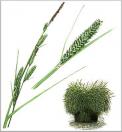Tufted Sedge - Carex elata
A perennial plant growing in strong, dense, cylindrical tufts up to a metre wide. The edges of the long, narrow (5 mm) leaves can cut on account of amount of accumulated silica.
The basal leaf sheaves, yellowish brown in colour, are keeled and often reticulate. The spikes, carried on stiff, triangular stems, are erect: the lower ones are female, the upper ones male.
This sedge prevalently grows on the banks of ditches and canals and along pool edges, but in suitable habitats where the soil is spongy and always holds water, it can cover large areas, forming the characteristic vegetation association known as magnosedge stands.
In particularly favourable conditions (e.g. at Sibolla) these stands can offer protection to rare and interesting plants like Hottonia palustris, Hydrocotyle vulgaris, Utricularia australis, etc.
Reclamation has meant a dramatic fall in the ecological space of the species, once very widespread especially in the Po Valley, the Pontine Marshes, Tuscany and Sardinia.
Until just after the second world war, the leaves of the Tufted Sedge were gathered for traditional weaving crafts: seat covers, mats, bags, baskets etc. After these traditional activities were abandoned, the plant declined even further especially since scything is no longer practised to check the growth of encroaching canes and reeds.
The Tufted Sedge loses out in competition with these infesting species.




